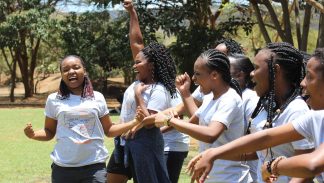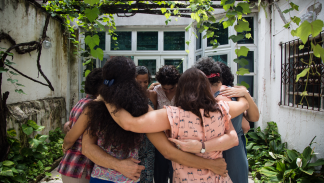Peru’s record flooding reveals need for women-led reconstruction, climate mitigation efforts
Recent floods and mudslides in Peru have created a crisis that highlights the need for more effective ways to prevent and confront natural disasters—and to empower grassroots women’s groups to lead crisis response and sustainable recovery efforts—in a world where all evidence points to the fact that they will only become more frequent and devastating.
Flooding has left at least 106 dead and hundreds more wounded, according to Peru’s National Emergency Operations Center. The government says some 156,000 have been forced from their homes, while relief agencies put the number of homeless at 700,000. With the cost of the flooding calculated at $3.1 billion and the cost of reconstruction estimated at $9 billion, the human costs are incalculable. This dramatic video shows a mud-covered woman, barely distinguishable from the swirling debris around her, emerging from a massive slide.
The government states that reconstruction efforts—including rebuilding more than 260 bridges that have collapsed—will take up to four years. In remote areas, some communities remain completely isolated due to washed out roads and bridges.
Women addressing immediate needs, assessing for long-term recovery
Women on the ground in Peru who are part of Global Fund for Women’s network of advisors and grantee partners emphasize the urgent need for shelter and rebuilding, as many women and families have been displaced. Access to basic necessities like clean drinking water and food, as well as health and sanitation are urgent issues—especially for remote communities that have been completely cut off from aid.
Longer-term impacts of the flooding on crops and land are also key issues for women in terms of food—both in terms of access to food for themselves and their families, as well as production and selling at local markets which some women depend on for income.
“There are freezing rains in the Andean area and a lot of rain on the coast. Where food was cultivated, in some cases the change in temperature is hurting the crops,” reports Tarcila Rivera, Global Fund for Women’s advisor in Peru and a Quechuan activist from the Center for Indigenous Cultures of Peru (CHIRAPAQ), a grantee partner.
“Insects have moved to higher elevations and they’re eating the flowers of the quinoa and potato. You can’t see the consequences now, but we´ll see them in the future,” she added. Quinoa and potatoes are the staples of the Peruvian diet, setting certain regions up for a possible food crisis in the aftermath of the flooding.
Health authorities are also bracing for an increase in cholera and skin diseases from the lack of pure drinking water, and life-threatening illnesses born by the mosquitoes that breed in the standing water, including dengue, Zika, and chikungunya.
Rebuilding homes, crops are most immediate needs for women
Global Fund for Women’s partner the Center for Urban and Rural Development (CEPDUR), based in Lima but working with women throughout Peru, reports that women urgently need materials to begin rebuilding their homes. Women in affected areas are asking for seeds to sow in the next harvest, and for help with replanting, and replacing the farm animals that communities rely on for daily food supply.
Natural disasters hit harder for women living and caring for children just this side of survival. Women make up the majority of the population living in extreme poverty in Peru and, as in other parts of the world, they’re responsible for feeding families and attending to the sick and wounded.
“Women are the ones out looking for food and resources,” Rivera stated. “They have to respond to their children’s cries for food, they go to wait in lines to get food and medicine when aid and supplies arrive.”
Women on the ground note that many of the families left homeless are indigenous communities that migrated to the coast of Peru. Although most have no resources for rebuilding, they do have a long communitarian tradition that teaches them that facing a crisis requires coming together. Peruvian indigenous and Afro-descendent women have long worked to maintain those bonds.
“These people are surviving because they are accustomed to responding as a community, for example, by cooking collectively,” notes Rivera, who has devoted over 20 years to defending and promoting the rights of Peruvian indigenous women.
Women as leaders & designers of sustainable, long-term recovery in Peru
“We’ve seen from our experience in other parts of the world that investing in women and grassroots women’s groups following disasters and crises recognizes not just women’s unique needs but also their capacity to organize collectively, distribute food and materials justly, find innovative ways to improve production, and build more sustainable communities. At the same time as doing all of this, women’s groups keep the lens on empowering women and continuing to advance women’s human rights,” says Musimbi Kanyoro, Global Fund for Women’s President and CEO.
Global Fund for Women and its partners on the ground in Peru are looking at the emergency relief and reconstruction efforts through a long lens. The destruction wrought by the floods exposed the vulnerability of buildings, roads, and water supplies. It also revealed the need to rebuild in new ways—ways that put women and their needs at the center of sustainable, resilient communities.
Although Peruvian officials are reluctant to blame global warming, citing the regular occurrence of flooding due to a Pacific coast phenomenon called “El Niño”, many experts, including UN specialist Robert Glasser, see a clear pattern related to climate change.
Peruvian women’s groups are focused on getting women involved in designing and leading long-term plans to deal with natural disasters in a nation that has been identified as particularly vulnerable. In particular, empowering indigenous women as leaders and contributors to these processes, and ensuring that their voices are heard, will be critical to responses in this and future climate crises.
“Now everything is out of balance, with this extreme weather, and disruption of production in the countryside,” Rivera said. “We, as indigenous women and indigenous peoples, believe it’s vital to take into account our knowledge to prevent and adapt to climate change, because the communities are the ones who know how.”
Photo credit: ERNESTO BENAVIDES/AFP/Getty Images. Woman holds her baby among flood water and damage in Piura in northern Peru on March 25, 2017.
Now everything is out of balance, with this extreme weather, and disruption of production in the countryside. We, as indigenous women and indigenous peoples, believe it’s vital to take into account our knowledge to prevent and adapt to climate change, because the communities are the ones who know how.”Tarcila Rivera


